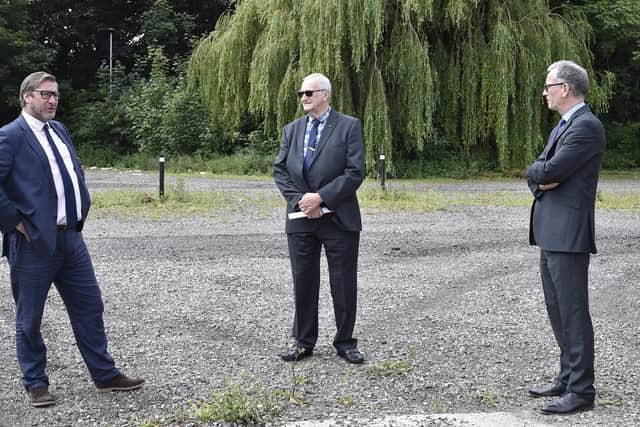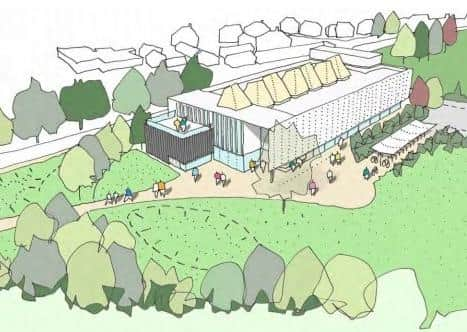New Peterborough university campus: No student parking, cheap bus travel, bicycle discounts and ‘little risk’ to road users
and live on Freeview channel 276
With the university, the nearby Fletton Quays development and plans for a new Peterborough United stadium all within a short proximity of each other, concerns have been raised about the potential levels of traffic in the area.
The transport and travel plans submitted as part of the planning application address this.
Advertisement
Hide AdAdvertisement
Hide AdIn the past five years there have been 80 accidents recorded in the nearby area, with police attending on 41 occasions.


Of these, 70 were categorised as being ‘slight’ in severity and the remaining 10 were categorised as being ‘severe’, with no fatalities.
Ten involved pedestrians, 18 involved cyclists and 13 involved powered-two wheelers. Just under half (36) occurred at or near to a crossing facility.
The place with the most accidents (16), as well as the most involving a “vulnerable road user,” was by the Bridge Street crossing near TK Maxx.
Advertisement
Hide AdAdvertisement
Hide AdThis was also the place which has seen the highest levels of traffic, with nearly 27,000 two-way vehicles over a 12 hour period from 7am to 7pm.


The Transport Plan states: “Given the high proportion of vulnerable road users crossing the A15 (accessing bus stops and the city centre) and the high proportion of traffic using the A15, the number of recorded accidents, whilst high, is not considered unusual given the ‘opportunity’ for conflict between vulnerable and motorised road users at crossing points.”
Moreover, it adds: “Since there are sufficient crossing facilities to accommodate safe and convenient access along the highway network... and given the arbitrary nature of the recorded accidents, it is unlikely that the development will have a notable or pronounced impact on local highway safety beyond what would be expected.”
The Transport Plan states that within the first three years of the campus opening, the maximum number of staff and students on site at any one time will be 904 (on a Tuesday between 10am and 11am).
Advertisement
Hide AdAdvertisement
Hide AdA parking survey has indicated that there will be 420 remaining spaces within the city centre once the Wirrina is no longer in use which has been deemed to be sufficient.
However, according to local travel statistics more than 50 per cent of people going into the city centre do so by car. If this continues once the campus opens this will mean more vehicles being used by university staff and students than the number of parking spaces available.
There would also be shortfalls between 11am and midday, and from 1pm to 3pm.
But the Transport Plan states: “The staff/student numbers presented are for a worst-case day of a worst-case week, which will only occur for a limited number of weeks throughout the academic year.”
Advertisement
Hide AdAdvertisement
Hide AdIn addition, it notes that a “robust and highly effective Travel Plan has been prepared in support of this application,” which it claims will limit the number of drivers.
Therefore, “it is considered that the development will not have a detrimental impact on city centre car parking but will make best use of the available space in accordance with local policy”.
Another potential issue which has been flagged is the “impact of the development on neighbouring residential areas”.
However, the Transport Plan notes: “The existing parking restrictions are extensive and are likely to deter any unwarranted parking from the development proposals.”
Travel Plan
Advertisement
Hide AdAdvertisement
Hide AdOne of the most striking aspects of the new university is its plans to limit the access of cars onto the site.
In total, there will only be 48 parking spaces - including six electric vehicle charging bays - compared to space for 154 bicycles.
The parking spaces will not be for staff, students or visitors, but will be for “disabled users and operational requirements, i.e. space for maintenance vehicles, staff gathering or dropping off teaching resources, short-term essential user permits, i.e. for block teaching or visiting academic staff, and a small proportion for car sharers”.
Anyone else wanting to take a car to get to the campus would have to use one of the nearby car parks.
Advertisement
Hide AdAdvertisement
Hide AdThe Transport Plan highlights the proximity of nearby bus stops and the train station, not to mention a “highly accessible pedestrian network which affords safe and convenient access throughout the local area”.
It adds that “the cycleway network is also extensive” and comprises “traffic free and quietly trafficked routes, affording access through the city centre”.
Part of the plan is to introduce two new bus stops near the campus and pedestrian access.
The university will hire a travel plan co-ordinator who will be expected to:
Advertisement
Hide AdAdvertisement
Hide Ad. Identify and promote specific travel initiatives such as ‘walk to work week’ and ‘bike week’ (including free bicycle maintenance for staff and students)
. Review and investigate methods by which to encourage participation of sustainable travel, including prize draws and free refreshments
. Provide a ‘cycle to work scheme’ for staff to purchase discounted bicycles and electric bikes
. Investigate and identify opportunities to obtain discounts on walking and cycling equipment from local providers, which would be made available to staff and students
Advertisement
Hide AdAdvertisement
Hide Ad. Identify opportunities to provide staff and students with free, branded equipment such as bike bells, umbrellas, personal safety alarms, reflective ‘slap bands’ and cycle locks.
Walking and cycle maps and information would be promoted via a Travel Information Pack, on the university’s website on notice boards, and through a phone app.
Staff and students “will be made aware from the outset that there is no car parking on site for commuters, that parking within the city centre is limited and that parking on surrounding local roads is not only discouraged but largely controlled through Traffic Regulation Orders preventing parking for non-residents,” the Travel Plan states.
And not only will single occupancy travel by car be discouraged, car sharing would be promoted through a “bespoke incentivised car share scheme”.
Advertisement
Hide AdAdvertisement
Hide AdThis would see a “small proportion” of the campus car park dedicated to car sharing, while it will be investigated whether a car club could be set up on site.
The Travel Plan states: “A car club car onsite would most likely be utilised by staff travelling between campuses and may therefore allow staff to travel to the site sustainability.”
Moreover, public transport discounts for staff and students will be sought from local service operators, with staff offered interest free loans to purchase season tickets.
The plan notes: “Given the number of staff and students expected to occupy the site in the short, medium and long term, (Anglia Ruskin) is able to negotiate extremely beneficial discounts that will further encourage staff and students to travel to the site sustainably”.
Advertisement
Hide AdAdvertisement
Hide AdFurther articles on the planning application will appear at https://www.peterboroughtoday.co.uk/.